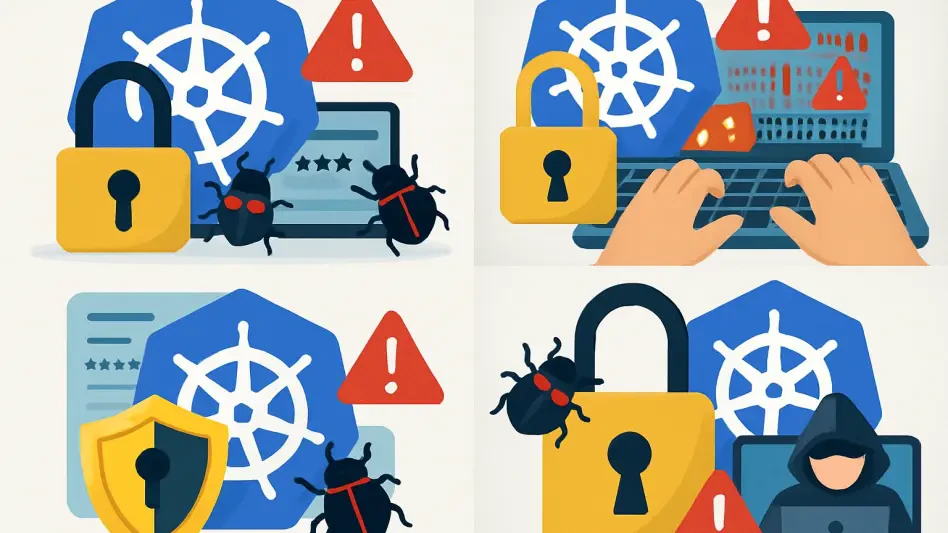In an era where cloud-native technologies underpin critical infrastructure, a newly uncovered vulnerability in the official Kubernetes C# client has sent ripples through the cybersecurity community, raising urgent concerns about the safety of communications with Kubernetes API servers. Rated at a medium severity of 6.8 on the CVSS scale, this flaw affects all versions up to 17.0.13 and opens the door to potential Man-in-the-Middle (MitM) attacks due to improper certificate validation. The implications of such a security gap are far-reaching, especially for organizations relying on secure connections over untrusted networks. This discovery serves as a stark reminder of how even subtle oversights in widely used tools can jeopardize entire systems. As Kubernetes continues to dominate container orchestration, understanding and addressing this vulnerability becomes paramount for maintaining the integrity of sensitive data and API interactions in complex environments.
Unpacking the Vulnerability’s Core Issue
The heart of this security flaw lies in how the Kubernetes C# client manages TLS/HTTPS connections when a custom Certificate Authority (CA) is defined in a kubeconfig file. Although the client performs a basic check to ensure that a certificate is well-formed, it falls short in validating the trust chain against the specified custom CA. This critical lapse means that the client may accept certificates signed by any valid authority, rather than strictly adhering to the intended CA. Such a gap paves the way for attackers on the same network to present forged yet validly signed certificates, effectively impersonating the Kubernetes API server. This kind of MitM attack enables malicious actors to intercept and decrypt sensitive traffic, including credentials, tokens, and other confidential information exchanged during communication. For environments that depend on custom CAs to secure connections over untrusted networks, this vulnerability poses a significant risk, potentially undermining the foundational trust mechanisms that safeguard Kubernetes operations.
Beyond the technical specifics, the broader impact of this flaw cannot be overstated, as it exposes a fundamental weakness in certificate validation that could be exploited with devastating consequences. Once an attacker gains a foothold through such an MitM position, they can manipulate API commands, alter configurations, or extract critical data, all while remaining undetected by standard security measures. This issue is particularly alarming for organizations operating in hybrid or multi-cloud setups, where secure communication across diverse networks is a daily necessity. The vulnerability highlights how even a single oversight in a widely adopted client library can ripple through countless deployments, affecting industries from finance to healthcare that rely on Kubernetes for scalable and secure container management. Addressing this flaw requires not just technical fixes but also a reevaluation of how trust is established and maintained in networked applications within the Kubernetes ecosystem.
Mitigation Strategies and Best Practices
For organizations affected by this vulnerability, the most direct and effective solution is to upgrade to the patched version, 17.0.14 or later, which implements proper trust chain validation to close the security gap. This update ensures that the Kubernetes C# client rigorously checks certificates against the user-defined CA, significantly reducing the risk of MitM attacks. However, for environments where immediate updates are not feasible due to operational constraints or compatibility issues, a temporary workaround involves adding the custom CA certificate to the system’s main trust store. While this approach can mitigate the issue in the short term, it comes with its own set of risks, as it extends trust to all processes on the machine for certificates signed by that CA, potentially expanding the attack surface. Administrators must weigh these trade-offs carefully, ensuring that temporary measures do not introduce new vulnerabilities while planning for a full update.
In addition to applying patches or workarounds, proactive steps can further strengthen security and prevent exploitation of similar flaws in the future. System administrators are encouraged to conduct thorough assessments of their Kubernetes environments, identifying all instances of the C# client in use and scrutinizing kubeconfig files for the presence of the certificate-authority field. Monitoring application logs for certificate warnings or connection errors can also provide early indicators of potential exploitation attempts, allowing teams to respond swiftly. Beyond these immediate actions, this incident underscores the importance of regular audits and timely patching as cornerstones of a robust security posture. By fostering a culture of continuous vigilance and rapid response to emerging threats, organizations can better protect their Kubernetes setups from subtle yet dangerous flaws that might otherwise go unnoticed until significant damage occurs.
Lessons Learned and Future Safeguards
Reflecting on this vulnerability, it becomes evident that even well-established tools like the Kubernetes C# client can harbor hidden flaws capable of compromising entire systems if left unaddressed. The incident exposed a tangible threat of MitM attacks stemming from flawed certificate validation, putting sensitive data at risk of interception. It also revealed how critical trust mechanisms could falter under specific configurations, particularly in environments reliant on custom CAs. This event served as a wake-up call for the Kubernetes community, emphasizing that security in cloud-native ecosystems demands meticulous attention to detail in both development and deployment practices. The collective response from administrators and security teams highlighted a unified commitment to safeguarding API communications through rigorous validation processes.
Looking ahead, the recommended path involves not only deploying the patched version promptly but also conducting comprehensive reviews of configurations and logs to detect lingering issues from past exposures. This episode reinforced the necessity of ongoing diligence in securing complex systems like Kubernetes, where a single misstep in trust verification could lead to significant breaches. By addressing this flaw through updates and careful monitoring, organizations took crucial steps to shield their environments against impersonation threats. Moving forward, adopting a proactive stance—through regular security audits, enhanced training on certificate management, and investment in advanced threat detection tools—remains essential to maintaining the integrity of API server interactions and preventing similar vulnerabilities from emerging in the future.








